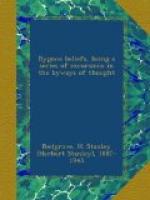[1] F. EDWARD HULME, F.L.S., F.S.A.: The History, Principles, and Practice of Symbolism in Christian Art (1909), p. 2.
The subject of symbolism in church architecture is an extensive one, involving many side issues. In these excursions we shall consider only one aspect of it, namely, the symbolic use of animal forms in English church architecture.
As Mr COLLINS, who has written, in recent years, an interesting work on this topic of much use to archaeologists as a book of data,[2a] points out, the great sources of animal symbolism were the famous Physiologus and other natural history books of the Middle Ages (generally called “Bestiaries"), and the Bible, mystically understood. The modern tendency is somewhat unsympathetic towards any attempt to interpret the Bible symbolically, and certainly some of the interpretations that have been forced upon it in the name of symbolism are crude and fantastic enough. But in the belief of the mystics, culminating in the elaborate system of correspondences of SWEDENBORG, that every natural object, every event in the history of the human race, and every word of the Bible, has a symbolic and spiritual significance, there is, I think, a fundamental truth. We must, however, as I have suggested already, distinguish between true and forced symbolism. The early Christians employed the fish as a symbol of Christ, because the Greek word for fish, icqus, is obtained by notariqon[1] from the phrase gr ’Ihsous Cristos Qeou Uios, Swthr—“JESUS CHRIST, the Son of God, the Saviour.” Of course, the obvious use of such a symbol was its entire unintelligibility to those who had not yet been instructed in the mysteries of the Christian faith, since in the days of persecution some degree of secrecy was necessary. But the symbol has significance only in the Greek language, and that of an entirely arbitrary nature. There is nothing in the nature of the fish, apart from its name in Greek, which renders it suitable to be used as a symbol of CHRIST. Contrast this pseudo-symbol, however, with that of the Good Shepherd, the Lamb of God (fig. 34), or the Lion of Judah. Here we have what may be regarded as true symbols, something of whose meanings are clear to the smallest degree of spiritual sight, even though the second of them has frequently been badly misinterpreted.




